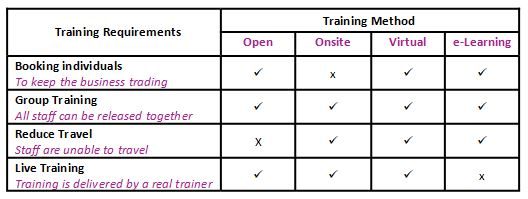Effective Training Planning for Your Business
Are you new to planning training for your company? Or maybe you don’t know what your options are and the best way to go about it.
We have created this checklist to make sure you & your business plan your training efficiently, effectively & accurately.
Follow these steps below;
1. Which Training Course Do We Need?
In order to choose the correct course, the best question to ask yourself is why are we doing this training? The answer will of course vary here, however some of the common answers are;
- For company safety & welfare
- For insurance purposes
- To improve our business
- To gain a contract
- For staff CPD
This should then help you decide which type of course you need. The options are generally accredited or in house. So what do these terms actually mean, well;
Accredited – Courses are approved by a national body & have a certain standard that must be met. This means they are generally recognised throughout the UK, which can be important for company insurance, industry approvals & business contracts.
Recommended Accredited Courses – First Aid, Food Safety, Water Training & IOSH
In House – Courses have been put together by your training provider to cover a number of criteria. These courses can become more tailored than accredited courses & therefore suit businesses looking to develop their practices & increase staff CPD.
Recommended In House Courses – Health & Safety Awareness Courses, Excel Workshops & Sage Training
2. How can this be delivered?
Your next area to consider is how can we get this training done. The logistics! There are 4 methods that we use for training;
Each method has it’s own pro’s & con’s so it is really down to which method works for your business.
This table highlights some of the considerations.
Within each training method courses can also be delivered out of traditional working hours including;
- Twilight Sessions
- Weekends
- In to night shifts
There is so much flexibility with our training courses it is worth discussing it with someone who can find the best solution to your exact situation. You can do this by contacting us.
3. Booking & Planning Training with Staff
Once you have found your course & best training method, you need to get it booked in and not just with your training provider. Dependent on your seniority in the company ensure you check;
At Work;
- The member(s) staff is available & does not have holiday booked
- The department can spare that member(s) of staff for the day(s)
- You have available space/rooms for training to be carried out (if onsite or online)
Training Provider;
- Your trainer still has availability for this course on your chosen date(s)
- You can supply staff names, national insurance number & DOB where applicable.
It is essential to check the above as the last thing you need is to enter the zone of cancellation fees. This should help you avoid them.
4. Preparing Candidates for their Training
To ensure your staff are fully prepared for their training, print off/email the booking confirmation you receive from the provider. This should include timings, directions, refreshment requirements & any pre-requisite materials.
Secondly ensure the invoice (if you pay on account) has been sent to your finance department. There is nothing worse than companies chasing you for money and it can delay your certificates being sent. Some providers believe it or not, won’t actually let you attend without paying first.
Most providers will email a course reminder a few days before your course. Pass this on to your candidate to check they have remembered, this will also help you avoid those cancellation fees if it slips their mind.
5. Training Management – Post Course
Your staff training records are just as important as planning training. Having a system where you can quickly find certificates for business contracts & insurance as well as knowing when renewal is due, can save a huge amount of effort later down the line. Most certificates are now issued electronically, so ensuring you save these to your computer is the most efficient method. Logging your training can be even more straight forward using a simple Excel spreadsheet. If you’re not sure where to start check out our staff training blog here.
6. Implementing Training
Finally check what your staff thought of their training & give them the opportunity to implement their new skills & ideas.
You always want to use the best providers and the best way to ensure this is by getting feedback from your staff. This may lead you to consider other courses in the future &/or look at alternative providers.
To get the most from your training, you need to ensure your staff have the opportunity to put their skills into practice. Of course we don’t want candidates to ever need their first aid skills for example, however they may have new ideas including additional products for your first aid kits or amended procedures. The more your staff can give back from training the better your business will be.


Covid First Aid Guide
/in First Aid Guidance /by KatieAs workplaces return it is important you remain compliant with HSE. We have put together a quick guide to performing first aid during the Coronavirus pandemic based on the HSE & Resus Council guidance.
We recommend sharing this guidance with your first aiders to ensure they remain safe as well as maintaining the safety of their casualties.